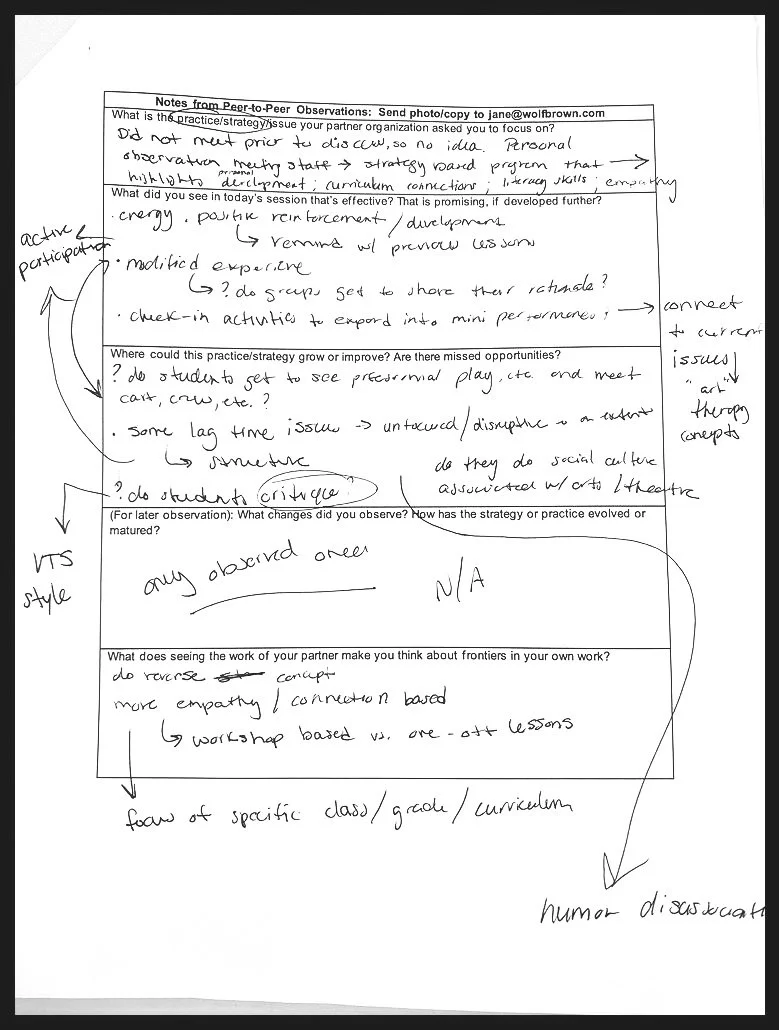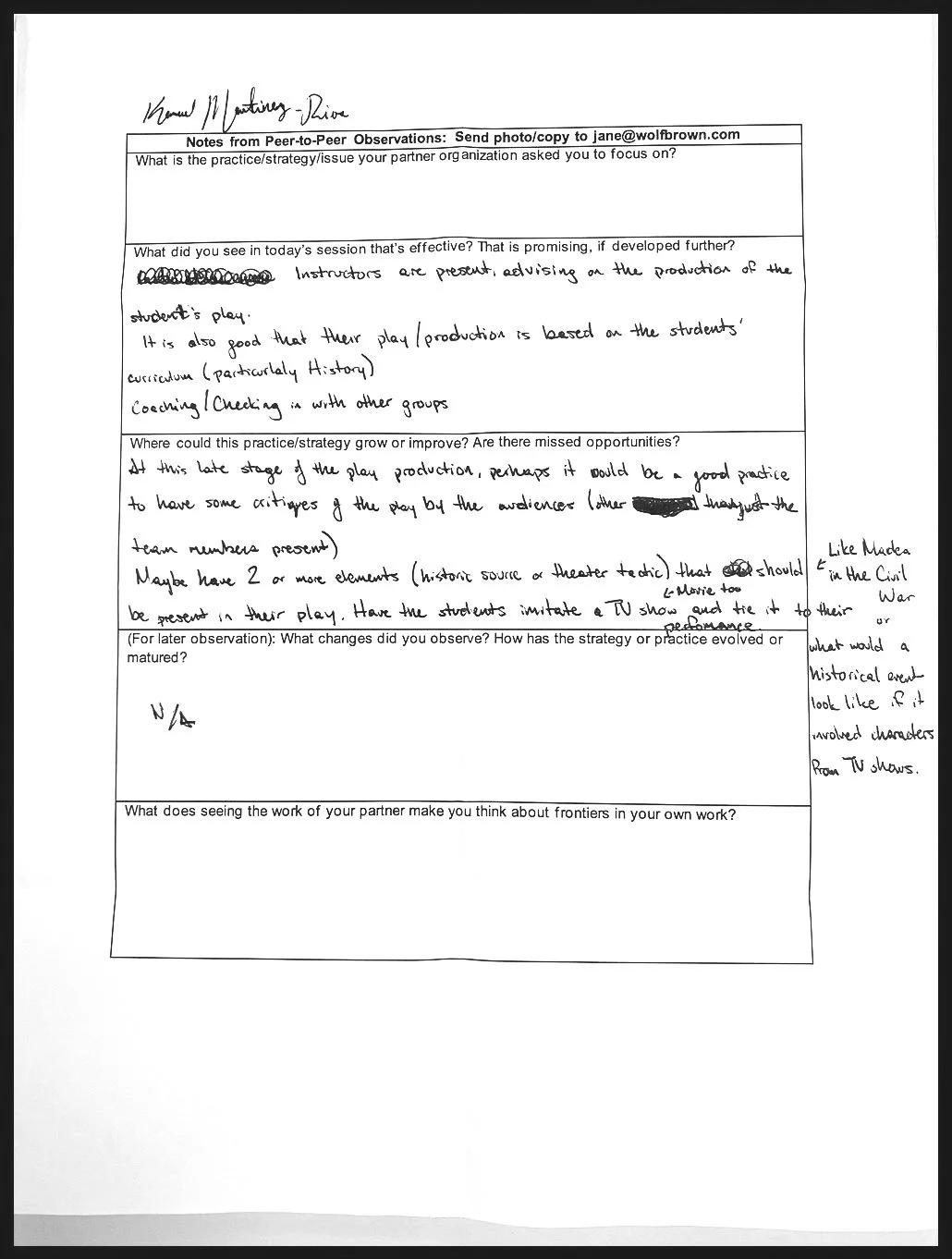Imagining The Future
How do we continue this work as the needs of students, teachers and parents evolve?
What are the next steps to advance this important work?

As part of this project, Philadelphia arts educators observed, reviewed, and learned from one another’s practices through a series of real-time, on-the-ground sessions followed by reflective conversations.
The full plan (which circumstances often challenged) called for:
Inviting organizations across genres and types of delivery to select partners whose work they wanted to see or whom they wanted as observers
Scheduling cross-visits with guiding questions
A follow-up conversations between partners on site, or later
A reflective interview about the process and how it could be strengthened
The development of a set of questions that could guide future peer-to-peer learning and exchanges of best practices
Sample Results
This pilot of peer-to-peer observations shows how much teaching artists and staff members at arts organizations have to offer one another, as the following example shows:
A team from PAFA (Pennsylvania Academy of Fine Arts) had the opportunity to observe a session presented by Lantern Theater Company. The PAFA team took notes about what they observed and admired in Lantern’s practice.
The first two pages show PAFA’s immediate notes; the final page shares notes about how Lantern’s practices informed their own as well as their suggestions for how the peer-to-peer process could be strengthened.
Notes from PAFA (Pennsylvania Academy of Fine Arts)
Guiding Questions for Future Observations
The process also yielded a suggested framework for evolving the kinds of brave new practices Philadelphia arts partners are working out. Rather than a traditional rubric with score points, participants suggested a series of open-ended questions that organizations might use to assess their own practices and that of peers whom they visit.
Final Reflections from Kemuel Martinez-Rios, School and Community Partnerships Coordinator of PAFA (Pennsylvania Academy of Fine Arts)
Using This Site Going Forward
There are many ways to use this site going forward.
Staying inspired:
The artist videos are well worth returning to – especially on “dark days” when teaching artistry is challenging or hard. These voices can be your artistic and ethical neighbors and colleagues. Call them up – or use them as a part of your organization’s own professional development resources.-Bethlehem the Vocussionist and Emma Terrell
-Libby Mislan and Samira Asma-Sadeque
-Maurice Emmanuel Parent and Megan Sandberg-Zakian
-Mae Early
-Dr. Kimberly McGlonn
Strengthening your own brave practices:
Through this project, it became clear how quickly the staff and teaching artists at arts partners can turn over at an organization. So, as you onboard new people, you might consider a program of peer-to-peer observation, pairing new artist/staff with more experienced members.In doing that you might:
-Listen to Kristina Berdan, Stephanie Wakeman and Jess Zweig discuss the powers of peer-to-peer learning processes for building brave practices in an organization.
-Expand the list of guiding questions so that the language and the specific questions link to your signature work and use them in regular cross-observations within your organization.
-Involve others in observations (e.g. Executive Directors, Development personnel, even Board members), so they understand the work of the organization deeply and understand what will help it flourish.
Learning from colleagues’ brave practices:
The many organizations who participated in the project are potential partners in your work. Browse their materials on this site and also their free-standing websites. For example, participants in this project connected with other arts partners to:-Share facilities like exhibition spaces or theaters for final performances
-Be peer observers offering insights from their practice that can invigorate others’ work.
-Provide models for extending programs beyond the classroom period: parades, public exhibitions, after-school hours, summer internships
-Share tips for engaging classroom teachers, principals, and families, building support for arts programming such that it becomes a valued part of a school’s culture and signature in the community.
Sharing your brave practices:
Many of the teaching artists and staff members who participated in this project appreciated “being seen,” “having our work acknowledged,” and being asked “questions that are at the heart of what we are trying to do.” Some even called it the “best professional development.” So, as you continue your work, consider building these kinds of opportunities into your ongoing work:-Make observing others’ brave practices a part of on-boarding new staff and artists. Schedule two such observations as an integral part of their first year.
-Invite others in: If you are launching a new program or approach, identify colleagues who are skilled in this area (artists, teaching artists, classroom teachers you have worked with), offer them a modest stipend, give them guiding questions about what to observe, invite them in, and hold a talk-back so you can get the feedback you need.
Build budgets and schedules that support this kind of learning:
Throughout this process, organizations raised questions about paying observers for their time and thought. “If it is that important, folks need to be compensated.” So, going forward, if arts partners value offering and receiving this kind of collaboration and feedback, they might:-Plan for peer-to-peer learning in their annual budgets. This would mean building in line item to support artists and staff to be learners.
-Fund raise for this work: This would mean explicitly asking donors and funders to support peer-to-peer learning. Once dollars are raised for initial work, staff and teaching artists could apply for these additional funds with a plan for their learning. Once completed, they could share their insights with other staff and write (or be interviewed) for an organization’s website. It is a tremendous opportunity to showcase how an organization contributes to the wider arts education community.
BE BRAVE.
ENGAGE.
EXCHANGE.
GIVE BACK.
BE BRAVE. ENGAGE. EXCHANGE. GIVE BACK.

Resources:
Additional peer-to-peer learning communities in arts education
-
Arts Assessment for Learning website shares information about the ways in which arts educators can collaborate to investigate building stronger practices. It is the product of a partnership between the New York City Department of Education’s Office of Arts and Special Projects and ArtsConnection, a model arts education organization recognized by the U.S. Department of Education (USDE).
-
CAN is a five-year grant initiative to create nationwide virtual Professional Learning Communities with educators in visual arts, music, theatre, dance and media arts. The purpose of CAN is to build a sustainable model of professional learning for arts educators in public schools and public charters to strengthen their pedagogy, instruction, and leadership skills in order to better serve students. Podcasts associated with this work are available here.
-
This is an open-source website developed by New York City teaching artists for their colleague teaching artists devoted to working to create more inclusive classrooms. https://teachwithgive.org/



